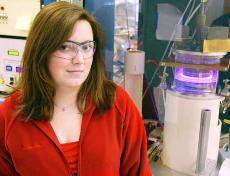A Coast Guard helicopter needs the ability to fly in devastating conditions. Fast-whipping winds and pounding rain are only small obstacles in an aircraft designed to save lives — so when materials fail it is no small matter.
Lab assistants in the materials science and engineering department, located on the third floor of Engineering Building I on Centennial Campus, are entrusted to find solutions to large-scale problems. Kristina Marshall, a senior in materials science and engineering, has devoted the past year and a half to life in the lab.
Her favorite research topic is failure analysis, where she discovers the problems that led to material failure. A couple of her projects have included Coast Guard helicopters.
“One part of the helicopter we worked on was a condenser that had too much pressure and poor material selection,” Marshall said. “This caused it to shotgun through the side of the helicopter.”
On the same aircraft, part of the exhaust ripped the turbine blade, which shot back through the exhaust and tore most of the metal apart. Marshall attributed the failure to improper welding.
Materials science includes metals, polymers, ceramics and electronics — a program that covers literally everything.
“Everything has to be made out of material,” Marshall said. “Refrigerators, tables and glass are all made from materials that need to be tested.”
Most of the labs she works on have to do with breaking things to learn what must be changed for them to work more efficiently. She pulls polymers until they snap and smashes glass to learn its properties.
One of the students’ favorite labs is impact testing, which identifies how much energy something needs to break. They take metal bars and let a machine equipped with a hammer do the dirty work.
Even as a field that employs students with the power to destroy and create, materials science and engineering remains a small field with only 12 students scheduled to graduate in May.
It is so small that all people in the entire department even have their own mailboxes for department news. The department head knows all the students’ names, according to Marshall. But most students outside of the program remain unaware that the program exists.
“Nobody ever knows what it is,” Marshall said. “They confuse it with textiles.”
Marshall became interested in materials science and engineering after two years as a chemical engineering major, when she took the introduction class as a requirement. The variation allowed her to explore different materials, and working in a small program opened opportunities to research that are usually not available to undergraduate students.
“I’ve done things in the lab that I don’t think I would get to do in another field,” Marshall said.
She spent five days this summer working at a military base on a materials project, an experience she attributes to having so much lab background at school.
Marshall works between 10 and 15 hours a week researching, on top of classes — a load that ties her to Centennial Campus at least eight hours a day.
“The past two days I have been on campus 14 hours a day. A light work week is about 8 hours a day,” she said. “On a good day I get six hours of sleep.”
Last year during exam week she stayed on campus working for a full 48 hours, her record stay on Centennial.
The problems she explores, such as failure analysis for the Coast Guard, make the long hours and lack of sleep worth it.
Marshall can use heat to increase metal strength and develop a proper band gap to control the movement of electrons. She took an aluminum alloy and treated it with a solution and heat, and as the metal cools it becomes a harder material. For semiconductors the distance between the N and P levels controls electron movement with a gap for the insulator, which controls how well it conducts.
Another project she has worked on over the past nine months has to do with renewable energy. The lab has funding from the Department of Energy and is working with a business partner to create a form of renewable energy from hog waste. The business has created a microbe that transforms the solids into methane and carbon dioxide.
“We take [the methane and carbon dioxide] and put it through atmospheric plasma, which is an ionized gas, typically hydrogen. The best way to describe it is as lightning,” Marshall said. “Right now we’re trying to see what we can get. We hope to have liquid so we can test that.”
Materials science is heavily research-based, and Marshall said the majority of materials science engineers do not take the engineer licensing test because most of the test does not apply to their field.
Marshall is the secretary of the Materials Technical Society, a group geared toward undergraduates learning and finding out information about jobs in their field.
“Of all the people who have come to talk, only 1 or 2 percent have their professional engineering license,” she said. “Only one of our seniors has taken it.”
Marshall will graduate in May, but has not taken the exam and does not plan to take it. She wants to go into research with metals or electronic materials. “Trying to understand the properties of material from how they currently work to another application,” is what motivates her.








